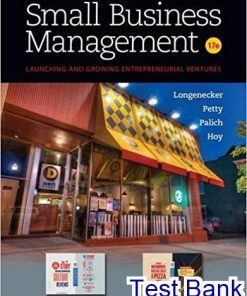Entrepreneurial Small Business 3rd Edition Katz Test Bank
$50.00 Original price was: $50.00.$26.50Current price is: $26.50.
Entrepreneurial Small Business 3rd Edition Katz Test Bank.
Entrepreneurial Small Business 3rd Edition Katz Test Bank

Product details:
- ISBN-10 : 0073381578
- ISBN-13 : 978-0073381572
- Author:
Entrepreneurial Small Business (ESB) provides students with a clear vision of small business as it really is today. It focuses on the distinctive nature of small businesses that students might actually start versus high growth firms. The goal of the companies described in this textbook is personal independence with financial security; not market dominance with extreme wealth. Traditional beliefs and models in small business are discussed, as well as the latest findings and best practices from academic and consulting arenas. Katz and Green recognize the distinction between entrepreneurs who aim to start the successor to Amazon.com and the pizza place around the corner. They discuss the challenges facing entrepreneurs, while keeping focused on the small businesses students plan to start.
Table contents:
Part One Entrepreneurs and Ideas: The Basis of Small Business
1(116)
Small Business: Its Opportunities and Rewards
2(24)
Starting an Entrepreneurial Small Business: Help Helps
4(1)
The Small Business Online Scavenger Hunt
4(4)
Defining a Small Business
5(1)
Small Business Owners and Entrepreneurs
6(1)
Small Businesses versus High-Growth Ventures
6(2)
Rewards for Starting a Small Business
8(1)
Myths about Small Businesses
9(3)
Getting Started Now: Entry Competencies
12(1)
BRIE Self-Assessment
13(1)
Small Business and the Economy
14(12)
New Jobs
15(1)
Innovations
15(1)
New Opportunities
16(2)
Two Aspects of Global Entrepreneurship
18(1)
Beyond Small Business: The Other Forms of Entrepreneurship
19(7)
Chapter Summary
Key Terms
Discussion Questions
Experiential Exercises
Mini-Case
Suggested Cases and Articles
Suggested Videos
Small Business Environment: Managing External Relations
26(30)
The Environment of Small Business
28(1)
The Elements of the Small Business Environment
29(1)
Finding Your Trade or Professional Association and Their Magazines
30(1)
Environmental Scanning for Small Businesses
31(1)
Finding Out How the Small Business Economy is Doing
32(1)
Five Skills for Managing Relations with the Environment
33(4)
Building Legitimacy
33(3)
Developing a Social Network
36(1)
Asking for Help
37(1)
Networking Skills
38(18)
Handling a Crisis
40(1)
Achieving Sustainability
41(1)
Making Ethical Decisions
42(14)
Chapter Summary
Key Terms
Discussion Questions
Experiential Exercises
Mini-Case
Suggested Cases and Articles
Suggested Videos
Small Business Entrepreneurs: Characteristics and Competencies
56(22)
The Entrepreneurial Personality
58(2)
Entrepreneurial Operational Competencies
60(1)
Competency Self-Assessment
60(3)
Professionalization
63(1)
Entrepreneurial Careers
64(1)
What Makes a Difference in Entrepreneurial Efforts
65(1)
Family Businesses
66(3)
Entrepreneurial Teams
69(1)
Women and Minorities in Small Business
70(1)
Second Career Entrepreneurs
71(7)
Chapter Summary
Key Terms
Discussion Questions
Experiential Exercises
Mini-Case
Suggested Cases and Articles
Suggested Videos
Small Business Ideas: Creativity, Opportunity, and Feasibility
78(39)
The Source of Business Ideas
80(4)
Work Experience
81(1)
A Similar Business
81(1)
Hobby or Personal Interest
82(1)
Chance Happening, or Serendipity
82(1)
Family and Friends
82(1)
Education and Expertise
83(1)
Technology Transfer and Licensing
83(1)
Screening Ideas
84(3)
From Ideas to Opportunities through Creativity
87(3)
Get into an Innovative Frame of Mind
90(1)
Avoid Pitfalls
90(1)
Types of Innovations Small Businesses Develop
91(1)
Make Sure an Idea Is Feasible
92(4)
Assessing Feasibility by Pilot Testing
96(1)
Ways to keep On Being Creative
97(1)
Great Ideas for Making Idea Prone Companies
98(19)
Chapter Summary
Key Terms
Discussion Questions
Experiential Exercises
Mini-Case
Suggested Cases and Articles
Suggested Videos
Sample Feasibility Study
103(14)
Part Two Small Business Paths & Plans
117(154)
Small Business Entry: Paths to Part-Time Entrepreneurship
118(34)
Why Part-Time Businesses Are Important
120(1)
When to Consider Part-Time Entrepreneurship
120(1)
Key Considerations for Success in Part-Time Entrepreneurship
121(1)
What Kinds of Part-Time Entrepreneurship Exist?
122(11)
Home-Based Business
123(3)
Internet Informational Web Sites
126(3)
E-Commerce and eBay Web Sites
129(4)
Checklist for Maximizing Success on eBay
133(6)
The Next Best Things to a Home-Based Business
136(3)
Success Factors for Part-Time Businesses
139(3)
Boundary: Separating and Balancing Business and Home
140(1)
Exchange: Dealing With Others
141(1)
Pricing and Costing
141(1)
What Are the Challenges of Being an Entrepreneur Part Time?
142(10)
Delegation and Outsourcing
142(1)
Making Do When You are Starting Out
143(1)
Ethics and Part-Time Small Business
144(2)
Moving from Part-Time to Full-Time Entrepreneurship
146(6)
Chapter Summary
Key Terms
Discussion Questions
Experiential Exercises
Mini-Case
Suggested Cases and Articles
Suggested Videos
Small Business Entry: Paths to Full-Time Entrepreneurship
152(30)
The Five Paths to Business Ownership
154(1)
Starting a New Business
155(7)
Advantages of Start-Ups
155(1)
Disadvantages of Start-Ups
155(1)
Creating a New Business
156(1)
Increasing the Chance of Start-up Success
157(4)
Special Strategies for Starting from Scratch
161(1)
Buying an Existing Business
162(1)
Advantages of Purchasing an Existing Business
162(1)
Disadvantages of Purchasing an Existing Business
162(1)
Finding a Business to Buy
163(1)
Finding a Business for Sale
163(7)
Investigating Entrepreneurial Opportunities: Performing Due Diligence
164(2)
Determining the Value of the Business
166(2)
Structuring the Deal
168(1)
Buyouts
168(1)
Buy-ins
169(1)
Key Resource Acquisitions
169(1)
Takeovers
169(1)
Franchising a Business
170(4)
What is Franchising?
170(1)
Advantages of Franchising
171(1)
Franchise Opportunities
172(1)
Legal Considerations
172(2)
Inheriting a Business
174(2)
Family Businesses Succession
174(1)
Developing a Formal Management Structure
174(1)
Succession Issues for the Founder
174(1)
Succession Issues for the Successor
175(1)
Ownership Transfer
176(1)
Professional Management of Small Business
176(6)
Chapter Summary
Key Terms
Discussion Questions
Experiential Exercises
Mini-Case
Suggested Cases and Articles
Suggested Videos
Small Busines Strategies: Imitation with a Twist
182(30)
Strategy in the Small Business
184(1)
Prestrategy: The First Step of Strategic Planning
185(3)
Owner Rewards
185(1)
Product/Service Idea and Industry
186(2)
Finding Your Firm’s Industry
188(3)
Imitation and Innovation
189(2)
Markets
191(1)
Customers and Benefits: The Second Step of Strategic Planning
191(1)
Value and Cost Benefits
192(1)
Checking Customer Opinions Online
192(3)
Industry Dynamics and Analysis: The Third Step of Strategic Planning
195(1)
Tool: Industry Analysis
196(1)
Short and Sweet Industry Analysis
196(2)
Strategy Selection and Implementation: The Fourth Step in Strategic Planning
198(3)
Tool: SWOT Analysis
201(1)
The Mechanics of a SWOT Analysis
201(2)
Post Start-Up Strategy
203(9)
Resources: What You Bring to the Firm
203(1)
Organizational Capabilities
204(1)
Discouraging Competitors
204(5)
Chapter Summary
Key Terms
Discussion Questions
Experiential Exercises
Mini-Case
Suggested Cases and Articles
Suggested Videos
Steps to an Industry Analysis
People also search:
entrepreneurial small business pdf
entrepreneurial small business 6th edition
entrepreneurial small business
an entrepreneurial venture and a small business
an entrepreneurial business owner must




















